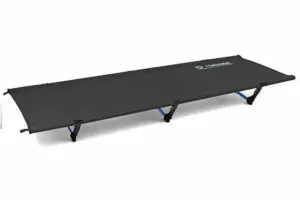How To Wash A Sleeping Bag [Step By Step Guide]

A sleeping bag is an essential piece of camping gear, but it gets dirty over time and needs to be washed occasionally.
This step-by-step guide will teach you how to wash a sleeping bag effectively and efficiently by yourself. For those who don’t have the time to wash the sleeping bags themselves, don’t worry. We’ll let you know where you can mail your sleeping bag to get professionally cleaned.
How To Wash A Sleeping Bag
Sleeping bags are made from different materials and fill. Each sleeping bag brand has its own washing instructions that should be followed closely.
Before we get the steps on how to wash your sleeping bag, consult the manufacturer’s instructions on the label or their website first before washing.
Let’s get to it.
Washing Down Sleeping Bags
Step 1.
Use a commercial front loading washing machine at the laundromat. The larger capacities will ensure that all of its fibers get rinsed thoroughly, and it’s safe from damages caused by the agitator column inside if you were to use a top loading washing machine, which could catch onto the sleeping bag and damage the feathers.
Thoroughly inspect the front load washing machine by running your hand or a piece of cloth along the insides. Move to a different machine if you feel any sharp or rough edges that can damage your sleeping bag. Also, make sure no loose items left behind from the last wash can cause damage, such as paper clips, safety pins, wax, etc.
Be sure to clean out the detergent dispenser carefully, as you don’t want old residue inside. If soap or additives from the last wash, you can run a pre-rinse with an empty load to remove all traces before your wash.
Step 2.
When washing your down sleeping bag in the washer, it’s important to use a proper cleaner. Use a special cleaner like Nikwax Down Wash Direct or one that says it’s safe for use on feathers. Avoid any conventional laundry detergent because it can leave residue and permanently ruin the loft.
Step 3.
Please make sure the sleeping bag is fully unzipped before washing to prevent snagging or breaking any of its components during the wash.
Step 4.
Follow the manufacturer’s instructions on the label for the proper water temperature and a gentle cycle setting to use. Typically you would be guided to machine wash in warm or cold water, but never hot, as this can damage some materials and cause them to shrink over time.
Step 5.
Once the first wash is complete, do another machine wash without any down cleaner to ensure your sleeping bag’s insulation has been rinsed fully.
Step 6.
Handle the down bag with care when taking it out of your washer. Support its entire length so that you don’t tear any seams and cause uneven insulation weight distribution.
Step 7.
Carefully roll your sleeping bag into a cylindrical form to remove extra water.
Step 8.
Refer to our section on properly drying your sleeping bag after washing here.
Washing Synthetic Sleeping Bags
Step 1.
Use a commercial front loading washing machine at the laundromat. The large capacity will ensure that all of its fibers get rinsed thoroughly, and it’s safe from damages caused by the agitator column inside if you were to use a top loading washing machine, which could catch onto the sleeping bag and damage your sleeping bag.
Again, thoroughly inspect the front load washing machine by running your hand or a piece of cloth along the insides. Then, move to a different front loading washer if you feel any sharp or rough edges that can damage your sleeping bag. Also, make sure no loose items left behind from the last wash can cause damage, such as paper clips, safety pins, wax, etc.
Be sure to clean out the detergent dispenser carefully, as you don’t want old residue inside. For example, if there’s soap or additives from the last wash, you can run a pre-rinse with an empty load to remove all traces before your wash.
Step 2.
When washing your synthetic sleeping bag in the washer, it’s important to use a proper cleaner. Use a special cleaner like Nikwax Tech-Wash (Note: This is a different wash from the same brand that we mentioned above for down sleeping bags) or one that says it’s safe for use on synthetic sleeping bags. Avoid any conventional laundry detergent because it can leave residue and permanently ruin the loft.
Step 3.
Please make sure the sleeping bag is fully unzipped before washing to prevent snagging or breaking any of its components during the wash.
Step 4.
Follow the manufacturer’s instructions on the label for the proper water temperature and spin cycle setting to use. Typically you would be guided to machine wash in cold or warm water, but never hot, as this can damage some materials and cause them to shrink over time.
Step 5.
Once the first wash is complete, do another wash without any cleaner to ensure your sleeping bag’s insulation has been rinsed fully.
Step 6.
Handle the sleeping bag with care when taking it out of your washer. Support its entire length so that you don’t tear any seams and cause uneven insulation weight distribution.
Step 7.
Carefully roll your sleeping bag into a cylindrical form to remove extra water.
Step 8.
Refer to our section on properly drying your sleeping bag after washing here.
Hand Washing Your Sleeping Bag
Some folks prefer to hand wash because it puts less stress on the bag.
You should fill your bathtub with cool or warm water, depending on the manufacturer’s recommendation on the label.
Add the proper cleaner for the type of sleeping bag you plan to wash:
- Down Sleeping Bag: Use Nikwax Down Wash Direct
- Synthetic Sleeping Bag: Use Nikwax Tech-Wash
Place the sleeping bag in a tub and gently work your way around, soaping up all areas of fabric. Rubbing heavily soiled areas will help remove any dirt. Let it soak for at least 15 minutes or up to an hour.
To remove all the soap from your sleeping bag:
- Drain the remaining water in the tub and refill it with cool or warm water.
- Gently press and remove all the suds.
- Repeat this process until there are no suds left.
- Let it sit for 15 minutes before draining off any excess water.
Once you’ve rolled out as much water as you can, lift and support the entire sleeping bag up and transport to the dryer. You don’t want to lift one side here as this will cause uneven weight distribution of the insulation material and cause stress in the seams.
Head back to our drying section to complete the drying process.
How To Dry Your Sleeping Bag

We recommend using a commercial dryer if possible, but a home dryer can be used as well if you don’t have access to a large dryer at the laundromat.
Use the low-heat setting on your drying cycle. This may take an hour or more for synthetic bags and longer for down. It’ll typically need one to three hours before they’re completely dry and ready to go back into their compression stuff sack. Down bags will take much longer, expect several hours.
Check every hour to avoid over-drying, which could damage the fabric.
For down sleeping bags, you can either add 2-3 clean tennis balls or wool dryer balls in the dryer to help break up any clumps and revive the loft of the down bag.
Dry cleaning is not recommended because the chemicals used in the process can damage your sleeping bag.
You can also let your sleeping bag air dry. It will put less stress on your sleeping bag but will take much longer to dry (longer than most people will think).
Lay your sleeping bag on a clean surface in an area with low humidity. Unzip the down or synthetic bag to allow the material of the bag inside to dry. Also, make sure the sleeping bag isn’t sitting in direct sunlight. Occasionally shake your sleeping bag, alternating sides to break up any clumps every hour.
Rainy Pass Repair Service

If you’re looking for a reliable and experienced service to clean and repair your synthetic or down sleeping bag, consider a company called Rainy Pass.
They have over 30 years of experience in the industry and are experts in repairing all types of sleeping bags. They use the highest quality materials and equipment, so you can ensure that your sleeping bag will be in good hands.
You mail in your sleeping bag, and they will clean it and fix any tears or holes in the fabric. They also replace the zippers, insulation, and other parts that may have worn out over time.
How To Keep Your Sleeping Bag Clean
If you’re a camper, hiker, or outdoor enthusiast, then you know the importance of a good night’s sleep. And part of having a good night’s sleep is making sure your sleeping bag is clean and in good condition. Sleeping bags can get dirty for various reasons, from exposure to body oils to contact with dirt and mud. But luckily, there are some simple ways to keep your sleeping bag clean and in good condition.
You can combat this by using a sleeping bag liner inside your bag when you’re sleeping in it to keep it cleaner, meaning you won’t have to go through the hassle of washing it as often.
Top Sleeping Bag Brand Care Instructions
We’ve compiled a table of the top sleeping bag brands’ care instructions below for your convenience.
| Brand | |
|---|---|
| Mountain Hardwear | Care instructions |
| Marmot | Care instructions |
| The North Face | Care instructions |
| Sierra Designs | Care instructions |
| Kelty | Care instructions |
| Feather Friends | Care instructions |
| Western Mountaineering | Care instructions |
| REI Co-op | Care instructions |
| Therm-A-Rest | Care instructions |
| Patagonia | Care instructions |
| Zpacks | Care instructions |
| Enlightened Equipment | Care instructions |
| Nemo | Care instructions |
| Big Agnes | Care instructions |
| Coleman | Care instructions |
| Sea to Summit | Care instructions |
| Exped | Care instructions |
| Mountain Equipment | Care instructions |
| Klymit | Care instructions |






